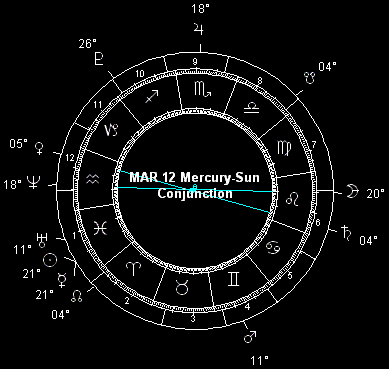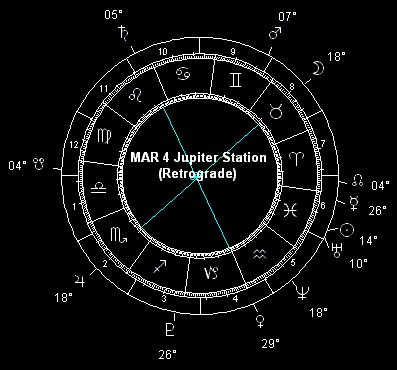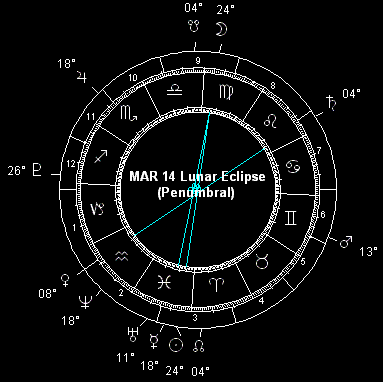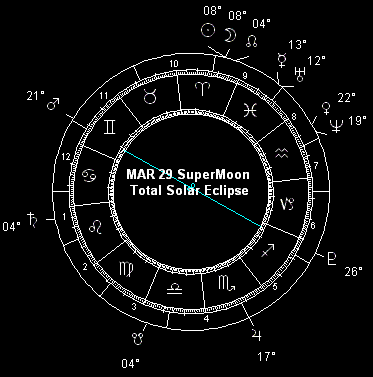If you were expecting some kind of sun sign nonsense, forget about it. This is real astrology for the real world. If it's real astrology for yourself that you want, you can get it by phone or in print. And if you need help deciphering the astrological glyphs in the graphics accompanying this article, see Astroglyphs: Astrological Symbols Guide. Please note: this forecast is expressed in terms of Universal Time (UT).
I don't try to describe the future. I try to prevent it.
-- Ray Bradbury
Forget all about that lamb stuff: March roars in like a lion, and then goes out the same way this year. From the February 28 SuperMoon with its geocosmic stress window that lingers until March 3, to the total penumbral lunar eclipse on the 14th, to the Moon hitting its most extreme declination of the year on the 22nd and the SuperMoon total solar eclipse on the 29th, this is a month that seethes with the kind of geophysical juice that stirs up powerful tides in the crust, oceans and atmosphere of our home planet. The most extreme storms, severe earthquakes and threatening volcanic eruptions of the year to date are sure to make headlines this month (and on into April).
While Mother Nature storms about like a bull in a china shop, human nature is fitful this month. There are a few sparks and explosions within a week or so of the 11th and 19th, when a couple Mars squares (to Uranus and from Mercury, respectively) speak of frayed wires and nerves, short circuits of one kind or another, leading to electrical fires, fiery tempers and other fiascoes; including terrorist atrocities and threats of war. With Mercury being intersolar all month, and retrograde as well from the 2nd through the 25th, accidents and malevolence are sure to wreak a certain amount of havoc around the Mars quadrature dates. Take precautions, proceed with care, keep an eye out for the other guy. Traffic tie-ups and other travel and transport delays are apt to be a major theme the whole month long, but the worst are likely around those Mars squares. This isn't the Apocalypse, but it could get messy if you don't watch what you're doing .
 There's a lot more to the March Mercury intersolar cycle than transport tangles. The intersolar cycle includes the little planet's March 2-25 retrograde, when Mercury appears to reverse its normal course through the sky. Of course Mercury doesn't actually shift into reverse. It's just that the swift inner planet catches up and passes the slower-moving Earth on the 'inside track' as it were. This time around, the intersolar cycle as a whole extends to Mercury as morning star reaching its maximum elongation west of the Sun on April 8.
There's a lot more to the March Mercury intersolar cycle than transport tangles. The intersolar cycle includes the little planet's March 2-25 retrograde, when Mercury appears to reverse its normal course through the sky. Of course Mercury doesn't actually shift into reverse. It's just that the swift inner planet catches up and passes the slower-moving Earth on the 'inside track' as it were. This time around, the intersolar cycle as a whole extends to Mercury as morning star reaching its maximum elongation west of the Sun on April 8.
As you can see from the animation, Mercury is much closer to Earth than usual during its intersolar phase. This is nature's way of telling us that all things mercurial are a higher than normal priority at these times. The mercurial elements of human experience are thought, communication, commerce and transportation, primarily: these will be prominent themes during the Mercury intersolar period. People who see it coming, who prepare and act accordingly, will prosper during this cycle. But those who are asleep at the switch will end up falling farther and farther behind. So plan, study, research, gather information and documentation in advance, and have fallback positions ready. Anticipating the importance of all that is mercurial means being alert, paying attention, being sharp and perceptive - and even that's no guarantee you won't succumb to the Murphy's Law stuff, but it's your best shot. Assume nothing, follow up on everything; stay informed, in touch and on top. Those who don't will get caught up in the miasma of missing information, missed connections and all kinds of messes and delays.
 Signs of Mercury intersolar include strikes and other disruptions affecting transportation and communication (e.g. postal, phone, mass transit, trucking, airline, shipping, dock and warehouse workers, teachers and all manner of media). Weather both terrestrial and solar (including geomagnetic storms) can play a part in the kind of breakdowns described here, but human effort (and sometimes malicious action) is a part of the mix as well. Power failures due to infrastructure breakdown and computer network disruptions caused by hacker attacks, software vulnerabilities and the like are also just a crossed wire or a keystroke away from a major mess at these times. It's not so much that disaster is destined to strike when Mercury is in its intersolar phase. Rather, it's that everything pertaining to Mercury becomes crucial; and unless it's treated as such, then it goes awry. Unfortunately, few people keep their eye on the ball with any consistency and diligence. Most people spend most of their lives sleepwalking around on autopilot. And that's the reason these Mercury cycles tend to turn into Murphy's Law festivals. While this applies to the whole month, it's likely to be especially pronounced during the March 2-25 retrograde, and particularly within a few days either side of Mercury's inferior conjunction with the Sun on March 12.
Signs of Mercury intersolar include strikes and other disruptions affecting transportation and communication (e.g. postal, phone, mass transit, trucking, airline, shipping, dock and warehouse workers, teachers and all manner of media). Weather both terrestrial and solar (including geomagnetic storms) can play a part in the kind of breakdowns described here, but human effort (and sometimes malicious action) is a part of the mix as well. Power failures due to infrastructure breakdown and computer network disruptions caused by hacker attacks, software vulnerabilities and the like are also just a crossed wire or a keystroke away from a major mess at these times. It's not so much that disaster is destined to strike when Mercury is in its intersolar phase. Rather, it's that everything pertaining to Mercury becomes crucial; and unless it's treated as such, then it goes awry. Unfortunately, few people keep their eye on the ball with any consistency and diligence. Most people spend most of their lives sleepwalking around on autopilot. And that's the reason these Mercury cycles tend to turn into Murphy's Law festivals. While this applies to the whole month, it's likely to be especially pronounced during the March 2-25 retrograde, and particularly within a few days either side of Mercury's inferior conjunction with the Sun on March 12.
Venus' long intersolar cycle concludes this month, at last. It began on November 3, 2005 as the "evening star" (Venus Vesper) attained maximum elongation east of the Sun. The cycle continued through Venus' retrograde (apparent backwards motion as seen from Earth), which began on December 24, 2005 and continued through February 3, 2006. The most intensive phase of this cycle was likely the inferior conjunction with the Sun on January 13, 2006; when Earth, Venus and Sun all lined up with Venus between Earth and Sun. (The Dow Jones index broke 11,000 for the first time in 4-1/2 years within a few days of this highly favorable conjunction. As the alignment began pulling apart, the Dow suffered its worse single-day loss in more than three years on January 20th.) The cycle wraps up on March 25 - the same day Mercury's retrograde ends - as Venus Lucifer (the "morning star") attains maximum elongation west of the Sun and passes behind the plane of the Sun as seen from Earth.
 As predicted in my World Forecast Highlights for last year, the current Venus intersolar cycle coincided with "an undercurrent of economic growth" in late 2005. So far, also as predicted, it's continuing into early 2006 and it has been "especially good for copper, gold and silver; for jewelry and fashion, for the entertainment industry." Also per my forecast, gold and silver have been "a complicated proposition, what with favorable lunar declination factors and an unfavorable Saturn transit": so we've seen these two precious metals trading in a range where ups mean hold and downs mean buy. Remember, as mentioned when discussing the favorable associations of the Venus intersolar cycle for last year's forecast, that "there are other indicators of a less favorable nature, so no one should expect unmitigated economic and financial improvement on a broad scale. Horrid oil price shocks will play havoc with the world economy off and on." This is even more the case in 2006, so make hay while Venus remains between us and the Sun. It's an idyll that will soon be followed by a storm, I suspect.
As predicted in my World Forecast Highlights for last year, the current Venus intersolar cycle coincided with "an undercurrent of economic growth" in late 2005. So far, also as predicted, it's continuing into early 2006 and it has been "especially good for copper, gold and silver; for jewelry and fashion, for the entertainment industry." Also per my forecast, gold and silver have been "a complicated proposition, what with favorable lunar declination factors and an unfavorable Saturn transit": so we've seen these two precious metals trading in a range where ups mean hold and downs mean buy. Remember, as mentioned when discussing the favorable associations of the Venus intersolar cycle for last year's forecast, that "there are other indicators of a less favorable nature, so no one should expect unmitigated economic and financial improvement on a broad scale. Horrid oil price shocks will play havoc with the world economy off and on." This is even more the case in 2006, so make hay while Venus remains between us and the Sun. It's an idyll that will soon be followed by a storm, I suspect.
By late March, what favorable economic tides there have been, are beginning to ebb - just as the benefic Venus cycle itself fades away. Mercury's direct station and Venus' maximum elongation both happening on the 25th are part of an array of signals indicating that an adjustment is due. Other indicators include Jupiter's retrograde station at 18° 52' Scorpio on the 4th, which has run up a degree of apparent motion by the 25th. (Jupiter's March station is right in the 2006 T-square territory.) Plus, there's Pluto's retrograde station at 26° 45' Sagittarius on the 29th, and Saturn's direct station at 4° 23' Leo on April 5.
All three planets are well with a degree of their station points throughout most if not all of March. This in combination with the aforementioned Mercury and Venus factors, plus Jupiter's March 16 square to Neptune, adds up to a change in the social, cultural, political and most especially economic spheres in the late March-early April time frame. While a steady state continuum is often taken for granted as the way things are - as if the future is sure to be just a continuation of the past and present - there are times when things reach a tipping point, and a whole new phase begins. This is one of those moments, although only briefly. It's a glimpse of changes to come, and for many people it will be unsettling. But in truth, this is only a fairly minor hiccup compared to what's to come - in the equity markets, in the commodity markets (including energy price shocks), in the balance of power within and between nations. As I've already pointed out, this is a system on the brink, and it won't take much to put it into a spasm. Moreover, Jupiter and Neptune are two of the keynote planets in the great 2006 T-square, so there's a lot more involved than petroleum. This is about banking, credit, the financial system; about confidence and trust, and how these things erode in time if they're not cultivated and reinforced. This isn't 'the Big One', it's only a tremor; a foreshock. The walls won't come crashing down now, but the cracks will be obvious and growing sometime in late March or early April. Plastering this stuff over is not the solution, but it's the best the people in charge can offer at this point.
As for those major geocosmic stress factors this month, it all begins at the beginning with the February 28 SuperMoon alignment, which anchors a risk window that extends through March 3. As I mentioned in my 2006 World Forecast Highlights, I figure that monstrously powerful windstorms appear to be the strong suit of this particular cycle, but the normal meteorological and seismic risks will still apply. Danger to ships and planes in transit on and over water seems greater than usual during this SuperMoon period. With Mercury and Venus both intersolar as well, commercial transportation appears subject to unusual disruptions - some of which is weather related, but not all of it. Travelers take care, and be prepared for delays.
In seismically active areas, an upsurge in moderate to severe earthquakes (Richter 5 and up) and volcanic eruptions would be par for the course at times like this. Coastal interests should prepare for higher than normal tides and heavy surf. Inland flooding, landslides and avalanches due to unusually heavy precipitation can happen over wide areas, wherever storms can reach - which is to say, just about anywhere at all. Still, the Great Plains from Alberta down through Texas and into central eastern Mexico are one of the major astro-locality map high risk sectors for this SuperMoon; also the Aleutian Islands and a north-south swath from central Greenland down through the eastern tip of Brazil; and, on the other side of the world, from eastern Australia and Papua New Guinea up through eastern Japan. Another north-south danger zone runs right through Delhi, another goes from Edinburgh down through Madrid and across West Africa, and the last of the major north-south risk lines for the February 28 SuperMoon runs through Wellington, New Zealand. And finally, there's an arc of instability that runs northeasterly through western Africa, across the Mediterranean and Florence, through eastern Europe and across northern Russia, curving southward to cross northern Japan and then into the Pacific.
 Once the SuperMoon stress window dies down after the 3rd, the next upsurge in storm, tide and seismic action comes with the Moon's north declination maximum on the 8th, which stirs things up from the 6th into the 9th. It's short, and probably not too sweet.
Once the SuperMoon stress window dies down after the 3rd, the next upsurge in storm, tide and seismic action comes with the Moon's north declination maximum on the 8th, which stirs things up from the 6th into the 9th. It's short, and probably not too sweet.
Next up in the way of geophysical stress factors is the year's first eclipse, a rare total penumbral lunar eclipse on March 14 at 24° 15'Virgo. In a penumbral eclipse the Moon passes through Earth's half-shadow (the penumbra), rather than through the total dark of the full-shadow cone (the umbra) cast by the Sun. Consequently, instead of disappearing as the full shadow of the Earth passes across it, the lunar disk becomes dusky in appearance when Earth's penumbra crosses its face. Greenland, Iceland, eastern Brazil, Africa and Europe are prime territory for this eclipse, which can be seen from beginning to end here - weather permitting, and in many cases the storm-driven clouds will get in the way. Heavy precipitation and unusually high tides appear to be a hallmark of this alignment, but it also carries a signature suggesting notable seismic activity (Richter 5+ quakes, as well as volcanic eruptions) and powerful electrical storms. Transportation, power and communications networks are especially susceptible to weather-related (and to a lesser extent, seismic-related) disruption during the eclipse, which is part of a geocosmic stress window that stretches from the 11th through the 17th. Although the risk of meteorological and seismic outbursts is planet-wide during this interval, astro-mapping suggests special risk zones in west Central Africa and Central Europe, along an arc from Athens through Bucharest and Kiev; and from Ontario down through Florida, across western Cuba and Central America, and along the coast of northwestern South America; a third arc sweeps up from Indonesia through Thailand, central China and Mongolia.
 The March 29 SuperMoon total solar eclipse is the big dog in the sky this month. It has an associated storm and seismic risk period that runs from March 21 through April 5, including as it does not only the perigee-syzygy but also the Moon's south declination peak on March 22, its northward equatorial crossing on the 28th, and the April 4 lunar north declination extreme. This period includes the highest lunar declination extremes of the year: 28°S43' on March 22, and 28°N43' on April 4 - although these marks will be tied in September. The combination of all these factors suggests this period has the potential to bring some of the year's most powerful storms, tidal surges, earthquakes and volcanic eruptions. Wind-driven wildfires are likely to make the news in a big way during this risk window - an obvious threat to life and property, and in the latter regard to power, communication and transportation infrastructure in particular. This particular eclipse is the 29th of 71 belonging to Saros Series 139, which began on May 17, 1501 and continues until July 3, 2763. (The first total eclipse of the series occurred on December 21, 1843 - a matter of months before the Bank Charter Act put England on the gold standard. Watch gold prices in late March and early April!)
The March 29 SuperMoon total solar eclipse is the big dog in the sky this month. It has an associated storm and seismic risk period that runs from March 21 through April 5, including as it does not only the perigee-syzygy but also the Moon's south declination peak on March 22, its northward equatorial crossing on the 28th, and the April 4 lunar north declination extreme. This period includes the highest lunar declination extremes of the year: 28°S43' on March 22, and 28°N43' on April 4 - although these marks will be tied in September. The combination of all these factors suggests this period has the potential to bring some of the year's most powerful storms, tidal surges, earthquakes and volcanic eruptions. Wind-driven wildfires are likely to make the news in a big way during this risk window - an obvious threat to life and property, and in the latter regard to power, communication and transportation infrastructure in particular. This particular eclipse is the 29th of 71 belonging to Saros Series 139, which began on May 17, 1501 and continues until July 3, 2763. (The first total eclipse of the series occurred on December 21, 1843 - a matter of months before the Bank Charter Act put England on the gold standard. Watch gold prices in late March and early April!)
The path of totality traced by this first solar eclipse of the year extends from eastern Brazil, across the Atlantic to North Africa and into central Asia. This zone of visibility is the first place to look for tidal, storm and seismic activity during the March 21-April 5 risk window. But the whole of Planet Earth is subject to this phenomenon, so people everywhere would do well to be on the alert. Astro-mapping may offer some hints to areas of special vulnerability outside the eclipse zone: Alaska and Hawaii and the Pacific coast of Canada; the southwestern US and the northern plains; along a north-south line running pole to pole through Miami in the western hemisphere and Bangkok in the east, as well as another north-south line through Melbourne, Australia; and one running through Johannesburg up across the Mediterranean and western Russia. And then there are the remaining arcs, one that runs southeasterly from northwest Africa down through South Africa, then sweeping northeasterly just off the west coast of New Zealand; another that traverses Scandinavia, western Russia and Ukraine to cross Turkey, the Middle East and the Horn of Africa; and lastly the Sun-Moon horizon line that arcs up from Perth to Shanghai. Be ready just in case: have your emergency kit handy, your water bottles filled, your batteries fresh and your candles trimmed.
 SPECIAL FEATURE: This month's birthdays of the famous and infamous (with astrological birth charts)
SPECIAL FEATURE: This month's birthdays of the famous and infamous (with astrological birth charts)